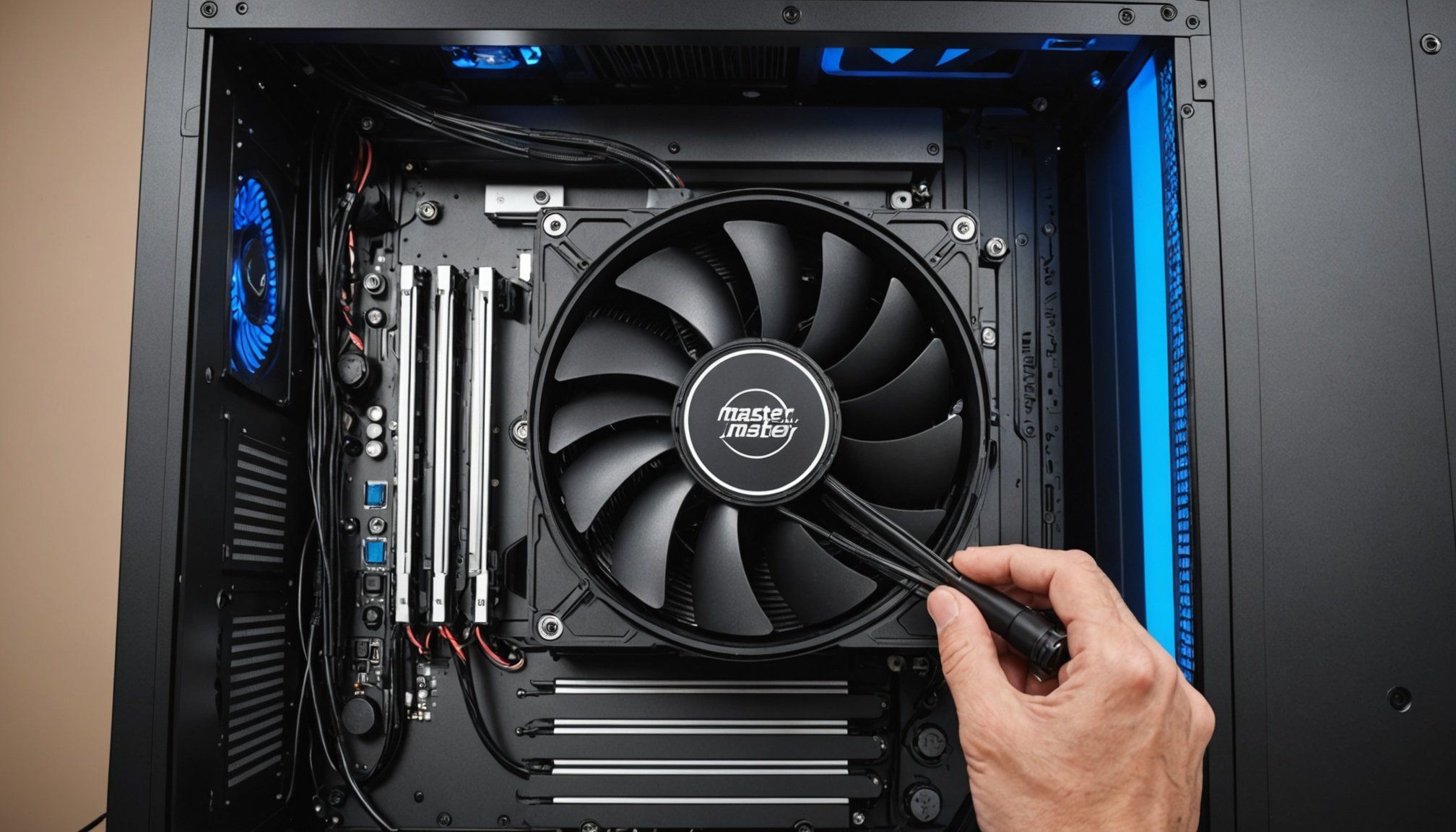Overview of Liquid Cooling Systems
Liquid cooling is celebrated for its superior performance compared to traditional air cooling, especially in high-demand systems. Its key advantage lies in the fluid’s ability to absorb and dissipate more heat efficiently, resulting in quieter operation since fans are minimized.
Key Components of Liquid Cooling
A liquid cooling system typically consists of several essential components:
- Radiator: Transfers heat from the liquid to the ambient air.
- Pump: Circulates the coolant through the system.
- Reservoir: Stores excess coolant and often aids in removing air bubbles.
- Water block: Sits atop the CPU or GPU, conducting heat into the liquid.
This setup ensures that liquid cooling systems are not only efficient but also customizable to suit various system needs.
Common Misconceptions
It’s a common misunderstanding that liquid cooling is prone to leaks. However, when properly installed and maintained, these systems are highly reliable. Another misconception is that these setups are complex and exclusive to experts, but many modern kits are designed for ease of use, making them accessible even to enthusiasts exploring liquid cooling for the first time. Understanding these components and addressing misconceptions enables users to appreciate and utilize liquid cooling technologies effectively.
Additional reading : Ultimate handbook for configuring a fast and secure vpn on your asus rt-ax86u router
Compatibility with Cooler Master MasterBox NR600
Incorporating a liquid cooling system in the Cooler Master MasterBox NR600 necessitates considering key specifications. This mid-tower case supports various cooling arrangements and is designed to accommodate Intel Core i9 processors.
When assessing case compatibility, note that the MasterBox NR600 features top and front radiator mounts—a 240mm radiator fits snugly in both locations, enhancing cooling efficacy for high-performance CPUs like the Intel Core i9. Ensuring your liquid cooling setup aligns with the NR600’s layout is crucial for optimal airflow and temperature management.
For users targeting precision, solutions compatible with the MasterBox NR600 include CPU water blocks that seamlessly integrate with the Intel Core i9, allowing the processor to operate under lower temperatures, boosting overall performance.
The MasterBox NR600 offers strategic cable management cutouts, aiding in neat tubing setup and preventing unwanted air pockets that may hinder coolant flow. Select liquid cooling kits designed for compatibility with this chassis, prioritizing efficient heat dissipation.
Balancing system integration and cooling proficiency, the Cooler Master MasterBox NR600 stands as a favourable choice. The seamless convergence of its design elements and liquid cooling systems ensures remarkable thermal management suited for high-demand applications.
Step-by-Step Installation Process
Stepping into the realm of liquid cooling installation can be both thrilling and challenging. This guide breaks down the process systematically to ensure success.
Preparation and Safety Precautions
Before diving into the liquid cooling installation, prepare your workspace. Lay anti-static mats and keep tools within reach to prevent damage and interruptions. Safety gear, such as gloves and eye protection, is a must to avoid injuries during installation. Taking these precautions ensures a smooth and safe experience.
Installing the Radiator
The radiator is crucial in dissipating heat from your system. Carefully position it in the case, checking that mounting spots align with your chosen Cooler Master MasterBox NR600 case. Secure it firmly to prevent vibrations, which could affect coolant flow. Remember, a well-mounted radiator guarantees effective heat exchange.
Setting Up the Pump and Tubing
Moving onto the pump and tubing, these components necessitate precision. Connect the pump to the CPU or GPU block, ensuring no leaks. Arrange the tubing smartly to minimise bends and maximise flow. Be mindful of any tubing that could kink, which might impede efficient cooling. An organised setup enhances performance and durability.
These straightforward steps outline a clear pathway for installing a liquid cooling system, laying the groundwork for optimal efficiency.
Connecting the Cooling System
Proper liquid cooling connections are critical for maintaining an efficient and secure system setup. Ensuring that tubing is both correctly placed and sealed prevents leaks and maximises performance. Start by assessing the layout of the tubing setup; align tubes with minimal bends to enhance the coolant flow. Excessive bends can lead to kinks, obstructing the flow and reducing the cooling effect.
When integrating the liquid cooling system with your build, attention to detail is crucial. Verify that all fittings and connections are tightly secured to avoid leaks. This includes double-checking connections to the pump, radiator, and water blocks.
Place a strong emphasis on electrical safety when handling system integration. Keep power connections secure yet accessible, ensuring they do not interfere with the tubing layout. A tidy configuration not only maintains aesthetic appeal but also optimises performance.
In conclusion, by focusing on each element of the tubing arrangement and ensuring seamless integration, you can achieve an enhanced and reliable liquid cooling system. This approach fosters efficient thermal management while promoting a long-lasting setup.
Performance Benchmarks and Testing
To evaluate the cooling efficiency of liquid cooling systems, specific performance benchmarks are employed. These benchmarks provide critical data on how well a system maintains optimal temperatures under various loads. Thermal testing measures the temperature drop and compares it to traditional air cooling systems.
When testing an Intel Core i9 paired with liquid cooling, results show significant temperature decreases, especially under intense processing tasks. The liquid system maintains cooler CPU temperatures, which improves system performance and extends hardware life.
Methods for Measuring Cooling Performance
Measuring cooling performance involves a series of tests simulating different workloads. These tests assess the maximum temperatures reached by the CPU during intensive tasks and monitor how quickly temperatures drop after the load subsides.
Comparison: Liquid Cooling vs. Air Cooling
In comparison, liquid cooling often outperforms air cooling by achieving lower operating temperatures. This efficiency is due to the liquid’s superior heat absorption properties and the enhanced heat dissipation capabilities of liquid cooling setups. Users seeking to enhance processor longevity and performance may find liquid cooling systems particularly beneficial.
Troubleshooting Common Issues
Navigating issues with liquid cooling systems requires keen troubleshooting skills. Despite their efficiency, problems may occasionally arise, particularly with the pump and coolant flow. Address these common liquid cooling problems swiftly to prevent extended downtime.
Identifying Common Failures
Regularly check for leaks, as they are a primary concern, especially if tubing connections are loose. Efficient troubleshooting begins by inspecting all points of connection: the pump, radiator, and fittings. Observe for unusual noises, which often indicate pump malfunctions.
Steps for Troubleshooting Pump and Flow Issues
- Inspect the Tubes: Verify that tubing is free from kinks or blockages, as these restrict flow.
- Check Pump Operation: Ensure the pump is receiving power and operating at the required RPM.
- Air Bubbles: Bleed the system to eliminate trapped air, which can disrupt flow efficiency.
Maintenance Tips for Longevity
Routine maintenance prolongs the life of liquid cooling systems. Regularly clean the radiator and replace coolant annually to maintain optimal cooling efficiency. Ensure fans are free of dust to support steady airflow. These ongoing practices minimise potential issues and safeguard your equipment.
Frequently Asked Questions
Navigating through liquid cooling systems can be daunting. Here we address common concerns and provide expert insights.
What are the benefits of liquid cooling compared to air cooling?
Liquid cooling offers superior heat dissipation and quieter operation due to more efficient thermal management and fewer fans. Integrating this system, especially in demanding environments, often results in lower temperatures and enhanced system longevity.
Are liquid cooling systems prone to leaks?
Properly installed and maintained liquid cooling systems are quite reliable. Concerns primarily arise from improper installation or neglected maintenance. Ensuring tight connections and regular inspections mitigates leak risks effectively.
What should first-time installers keep in mind?
Key considerations for beginners include understanding the components, such as radiators, pumps, and tubing setup. Start with a comprehensive guide, and don’t rush the installation. Pay special attention to safety precautions like grounding and organizing the workspace. Familiarize yourself with your case compatibility, ensuring that all elements of your liquid cooling system fit well and function efficiently.
Incorporating these insights, even newcomers can embrace liquid cooling, benefiting from its efficient performance and reliability.











